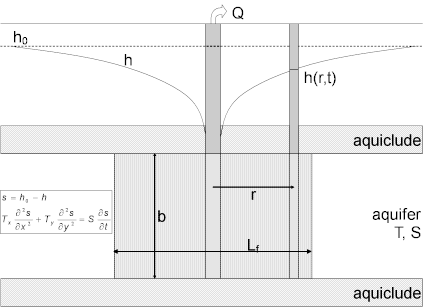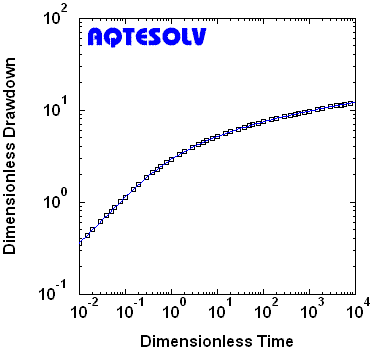Gringarten and Witherspoon Solution for Fractured Aquifers with a Single Vertical Plane Fracture
- Assumptions
- Equations
- Data requirements
- Solution options
- Estimated parameters
- Curve matching tips
- Benchmark
- References
Related Solution Methods
Additional Topics

A mathematical solution by Gringarten and Witherspoon (1972) is useful for determining the hydraulic properties (hydraulic conductivity, specific storage, hydraulic conductivity anisotropy and fracture length) of fractured aquifers with a single vertical plane fracture intersecting the pumped well. Analysis involves matching the solution to drawdown data collected during a pumping test. The solution estimates hydraulic conductivity anisotropy in a horizontal (x-y) plane.
AQTESOLV provides two configurations for simulating a vertical fracture using the Gringarten and Witherspoon (1972) solution: uniform flux and infinite conductivity. Select the appropriate condition when you choose a solution.
You are not restricted to constant-rate tests with the Gringarten and Witherspoon solution. AQTESOLV incorporates the principle of superposition in time to simulate variable-rate and recovery tests with this method.
The early-time response of a pumped well intersecting a vertical fracture has a distinct signature that you can diagnose with a linear flow plot.
Due to anisotropy, use of a distance-drawdown plot with the Gringarten and Witherspoon solution is limited to wells located on the x-coordinate axis.
Assumptions
- aquifer has infinite areal extent
- aquifer has uniform thickness
- aquifer potentiometric surface is initially horizontal
- pumping and observation wells are fully penetrating
- fractured aquifer represented by anisotropic nonleaky confined system with a single plane vertical fracture that fully penetrates aquifer
- flow is unsteady
- water is released instantaneously from storage with decline of hydraulic head
- diameter of control well is very small so that storage in the well can be neglected
Equations
The following equation by Gringarten and Witherspoon (1972) predicts drawdown in a nonleaky confined aquifer with a uniform-flux vertical fracture:
where
- is the error function
- is pumping rate [L³/T]
- is drawdown [L]
- is storativity () [dimensionless]
- is elapsed time since start of pumping [T]
- is transmissivity in x direction () [L²/T]
- is transmissivity in y direction () [L²/T]
- is a variable of integration
- is distance in x direction [L]
- is half-length of fracture in x direction [L]
- is distance in y direction [L]
Notes
- Equations (1) through (5) assume a uniform-flux condition along the fracture.
- Gringarten, Ramey and Raghavan (1974) found that equations (1) through (5) could be used to predict drawdown in an infinite-conductivity fracture by simply using = 0.732 to compute drawdown in the pumped well.
Data Requirements
- pumping and observation well locations
- pumping rate(s)
- observation well measurements (time and displacement)
- saturated thickness
- length of fracture
Solution Options
- variable pumping rates
- multiple pumping wells
- multiple observation wells
- boundaries
Estimated Parameters
- (hydraulic conductivity in x direction)
- (specific storage)
- (hydraulic conductivity anisotropy ratio)
- (length of fracture)
Curve Matching Tips
- Use linear flow plots to help diagnose linear flow.
- Match the Cooper and Jacob (1946) solution to late-time data to obtain preliminary estimates of aquifer properties.
- Choose Match>Visual to perform visual curve matching using the procedure for type curve solutions.
- Use active type curves for more effective visual matching with variable-rate pumping tests.
- Select values of from the Family and Curve drop-down lists on the toolbar.
- Use parameter tweaking to perform visual curve matching and sensitivity analysis.
- Perform visual curve matching prior to automatic estimation to obtain reasonable starting values for the aquifer properties.
Benchmark

References
Gringarten, A.C. and P.A. Witherspoon, 1972. A method of analyzing pump test data from fractured aquifers, Int. Soc. Rock Mechanics and Int. Assoc. Eng. Geol., Proc. Symp. Rock Mechanics, Stuttgart, vol. 3-B, pp. 1-9.